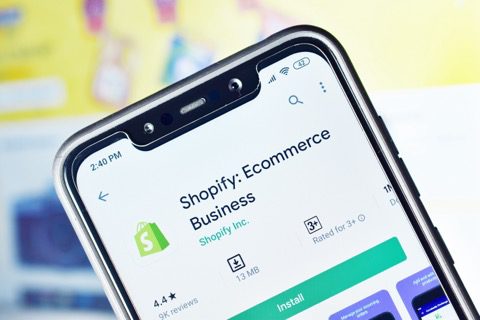
Get ready as we dive into the highly anticipated launch of the Winter ’24 Edition by Shopify on the morning of January 31.
The event promises an exploration of Shopify’s latest advancements, with key insights delivered by none other than Shopify’s VP of Product, Glen Coates. As we embark on this virtual journey, our live blog will be your go-to source for key updates and highlights, ensuring you stay in the loop on the most groundbreaking features and foundational updates unveiled during the event.
Here’s the updates as we catch them (we’ll literally post new updates at the bottom of the article as they’re announced):
Table of Contents
More Complex Products and Attributes
More product variants – They have improved the foundations of their product model by addressing a longstanding merchant frustration – 100 product variant limit up to 2000 progressively through 2024. Shopify’s product variant limits have been one of the most bizarre issues on the platform, to the point of being a running joke among everyone in ecommerce. Great to see this finally getting resolved.
Combined Listings app – Shoppers expect to see images of the exact color they are planning to purchase. Shopify Combined Listings app in early access allows merchants a parent product that comes in a bunch of options with each option as a child product with its own description, media carousel, and dedicated URL but all appearing on a single product page as one listing. A running knock on Shopify is its ability to handle complex catalogs well, and that seems to be a theme that Shopify is addressing this year.
New standardized product taxonomy – They’ve also made some big updates to the way products are created and managed in Shopify. In early access today, they are introducing a new standardized product taxonomy. As a product in the admin, the new category card on the product page automatically applies category-specific product attributes, saving you time and effort, and allowing you to store complete and consistent data across your catalog. We’re glad to see some of these features also showing up in early access, which means most Shopify merchants should be able to utilize them before H2 of 2024.
Blocks
Reusable blocks – Shopify is also making foundational edits to your store to tell your brand’s story the way you want. Each text block has different features, but more often than not it throws people off because they’re not all the same. With reusable blocks, developers will only have to define theme blocks once, and then repurpose them across sections to eliminate redundant work and coding, ensuring a consistent experience for merchants no matter where in the theme it is. From a Shopify dev agency perspective, this is a super helpful addition!
Nesting blocks – They’re also launching the ability to nest blocks up to eight layers deep. Previously, blocks couldn’t be nested in other blocks. With the ability to nest blocks, the multi-column section can now expose individual blocks for image, text, and link which gives merchants the freedom to reorder or add additional blocks in each column – These updates are in developer preview today. Shopify is definitely making a lot of Shopify devs and Shopify website managers feel pretty good with some of these announcements. ESPECIALLY since these are in preview now.
We’re now hitting 9AM PST and the updates keep rolling out. Here’s the latest group of Shopify 2024 Winter Editions releases:
B2B Functionalities
B2B user permissions – A major B2B update- available today, Shopify now supports sales reps in the admin. With a few clicks, you can set permissions for these B2B users to only access the accounts that are assigned to them by assigning roles. Setting up roles with permissions is easier than ever which saves you time each time you add a new rep. These reps will only see the orders, customers, and companies that are assigned to their accounts. This is another big win for Shopify. While their B2B offering has improved it was still behind what BigCommerce and others were offering. This helps close one of their bigger gaps.
Today, devs can use the new permissions API to build apps for B2B, but in the future, this can extend to all merchants for things like making sure regional employees only see customers in their region or for merchandisers to only have access to the products for the brands that they are allowed to manage. Again, we’re seeing Shopify close some key functionality gaps, not just for B2B merchants but large enterprise merchants. This feature also has trickle down benefits to merchants of all sizes with more complex selling models or management models. Shopify’s ability to really support (seamlessly) higher complexity merchants has always been a challenge so we’re seeing an effort to address that.
Fulfillable inventory – Today, Shopify is also introducing fulfillable inventory. This ensures browsing your store and going through checkout shoppers only see market-specific, real-time accurate views of in-stock inventory in the region. Another killer addition to help quiet the complainers (us included!) about Shopify’s willingness and ability to support more complex selling scenarios. Inventory management issues were always in the forefront of merchants’ minds, so cool to see this roll out!
Checkout Enhancements
Checkout extensibility is the way to customize your checkout using app-based customizations that are flexible upgrades, safe, and integrated with Shop Pay. You can also customize the entire buyer journey from checkout down to a completed order that lands on the thank you page using checkout extensibility.
There are 90+ new apps available today that are built for checkout extensibility that enable up sales, loyalty programs, and post-purchase surveys that were previously only achievable through custom code and would require your checkout to fall off the upgrade path.
Today, Shopify also released 14 new checkout APIs and updates including advanced branding controls and more ways to customize delivery options.
We’re still waiting on news on whether these features are going to be widely released to all merchants or if there are some plan limitations attached to these.
Improved checkout page-load times – Shopify has stated they’ve reduced checkout page-load time by 95% globally. Shopify also reduced their storefront page-load time by over 35% and expanded their web infrastructure to 300 points of presence globally. Curious to find out how these percentages were “mathed”. Sometimes Shopify gets a bit self congratulatory in its way of analyzing data and presenting these metrics (to be fair, its their sales and marketing call we’re listening to).
Analytics
New web performance dashboard – All Liquid storefronts have access to a new web performance dashboard where you can get trusted insight into your real user experience. Using the dashboard, you can analyze and monitor your customers’ experience across 3 industry standard core web vitals, which can help positively impact your store’s page ranking and conversion. We’re curious to see this one. Shopify’s dependency on apps has often led to poor performance and Shopify has tried to shift the blame away from their core product to others (while still requiring app dependencies). I wonder if this will be more of the same (“We’re fast, it’s the other guys you work with that aren’t…”) or more productive.
Customer and Merchant Experience
Exchanges – Now, merchants can create, track, and manage exchanges for any order in Shopify, allowing them to provide a great post-purchase experience while also retaining revenue. They can trust Shopify to automatically calculate refunds, payments, taxes, and inventory adjustments automatically. This will hit a few of the shipping partner apps. Great addition to the Shopify suite of features relating to back off fulfillment but a good reminder to app providers, Shopify isn’t afraid to eat your lunch. I’ve argued that to survive well into the future, Shopify needs to increase its value as a back office provider. As social platforms like TikTok try and muscle in on commerce, Shopify will still need merchants to view at as a valuable resource if their storefronts aren’t as important.
Test Drive – Shopify has enabled exchanges through a new settings page called Test Drive, which is a new tool for Plus merchants to train staff and test new capabilities and new APIs with your existing apps and integrations before rolling it out to your production stores at a time that’s right for you. Sounds like that may mean that Exchanges overall is a Plus feature? We do love the better testing and mature ‘go live’ sequence being highlighted here. Definitely something you need if you’re moving away from a small business first mindset.
Customer Account Extensibility – With Customer Account Extensibility developers can build extensions and brand new login experiences for merchants and their customers. This is built on the same platform as Checkout extensibility which ensures all the familiar capabilities and components of checkout extensibility work seamlessly with new customer accounts. Another win for increasing the ability to support more complex ecommerce scenarios. I highlighted this earlier but the storefront of old needs to die as ecommerce happens more and more through content channels. The new storefronts need to be richer and more distinctive in how they can support key customer groups and audiences.
Customer Targeting
Shopify Audiences lets merchants generate custom targeted audiences across top ad platforms. With the volume of commerce that happens on Shopify, we are uniquely positioned to put our scale back into the product to help improve digital advertising for all Shopify merchants. We’ve loved Shopify Audiences conceptually and hope to see more meaningful opportunity to use Audiences for all merchants.
Shop Campaigns is a low-lift acquisition program meaning that merchants don’t have to worry about creative assets or complex configuration and targeting, but instead, they have a powerful way to pay only for converting customers by setting a cost-per-acquisition target and letting Shopify do the rest.
Financing
Shopify Term Loans are an iteration of their existing capital offering that provides a more customizable and predictable landing option for merchants looking for fixed payments over a fixed payback period. Starting this month, they are releasing Shopify Line of Credit, which provides flexible, on-demand funding that merchants can use whenever they need to.
AI
Shopify Magic – Today, they are rolling out new Shopify Magic features in the media editor that use generative AI to make product image editing and enhancement easier than ever. With these new AI-powered background editing features, you can select from common style presets for an instant boost of professionalism; reimage the scene altogether with a short description of what you’d like to see; or instantly match the background of your existing photo shoots to make your storefront feel more on-brand and cohesive.
And that’s a wrap!
Tons of really exciting announcements and we’re eager to get to showcase some of these publicly for more of our merchants.
For more info on launching on Shopify, checkout our The Most Comprehensive Shopify Store Setup Guide Ever to kicking off your first store.



